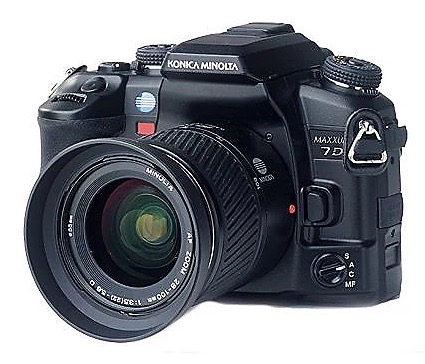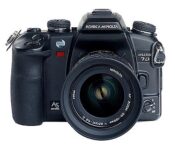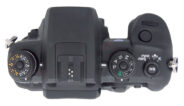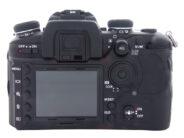Announced
Production status
Konica Minolta A APS-C system cameras
Konica Minolta Maxxum 7D
aka A-7 Digital
aka Konica Minolta Dynax 7D
APS-C AF digital SLR camera • Discontinued
Specification
| Format: | |
| APS-C | |
Imaging sensor: | 23.5 × 15.7mm CCD sensor |
Resolution: | 3008 × 2000 - 6 MP |
Crop factor: | 1.53x |
Sensor-shift image stabilization: | Yes |
| Minolta/Sony A [44.5mm] | |
| Shutter: | |
Type: | Focal-plane |
Model: | Electronically controlled |
Speeds: | 30 - 1/4000 + B |
| Exposure: | |
Exposure metering: | Through-the-lens (TTL), open-aperture |
Exposure modes: | Programmed Auto |
| Aperture-priority Auto | |
| Shutter-priority Auto | |
| Manual | |
| Physical characteristics: | |
Weight: | 760g |
Dimensions: | 150x106x77.5mm |
Manufacturer description #1
February 12, 2004
Konica Minolta Interchangeable-Lens Digital SLR Cameras
Konica Minolta is very proud to announce development of the interchangeable-lens digital single lens reflex cameras Dynax 7 Digital / Maxxum 7 Digital / α-7 Digital. These models are slated to go on sale in autumn of 2004.
The Dynax 7 Digital / Maxxum 7 Digital / α-7 Digital* will accept the Minolta A mount, compatible with the full range of Minolta AF lenses, as well as Maxxum/Dynax/α system accessories. Combining the best of established 35mm system photography with digital photography affords photographers the ability to more fully express themselves than ever before.
The Dynax 7 Digital / Maxxum 7 Digital / α-7 Digital is also equipped with the same technically sophisticated and highly effective CCD Shift-type Anti-Shake function, which has earned an excellent reputation in the DiMAGE A1 (SLR- type digital camera with built-in lens). As the Anti-Shake function is built into the camera body and not the lens, it is effective for the entire range of Minolta AF lenses. Thanks to the intuitive control layout being carried over from the three-time international award winning** and popular 35mm film AF SLR camera Dynax 7 / Maxxum 7 / α-7, the Dynax 7 Digital / Maxxum 7 Digital / α-7 Digital is a user-friendly and compatible design for 35mm film SLR camera users, enabling a smooth shift over to digital. Utilizing an APS-C sized 6 mega pixel CCD and advanced image processing technology, the resulting exquisite detail from highlights to shadows will satisfy even the most demanding photographers.
Konica Minolta is committed to develop additional digital SLR camera bodies, more interchangeable lenses, and other accessories to grow with digital SLR camera users' needs and the progress of technology.
* - The Maxxum 7 Digital is for the North American market, the α-7 Digital is for the Japan and China market, and the Dynax 7 Digital is for Europe and other all regions outside North America, Japan and China.
Products Highlights
- Accepting the Minolta A mount, current owners of Minolta AF lenses will be able to use them on this model
- With the CCD Shift in the camera body, the Anti-Shake function is effective with all lenses that can be used on this camera.
Note: The Dynax 7 Digital / Maxxum 7 Digital / α-7 Digital has been tentatively named for this release, with the final name to be announced at a later date.
Manufacturer description #2
Konica Minolta is delighted to unveil the Konica Minolta Dynax7D/Maxxum7D. This groundbreaking new 6.1-million-pixel resolution, lens-changeable digital camera is the world’s first digital SLR boasting a body-integral CCD-shift, “Anti-shake” (camera-shake compensation) technology that combines enhanced picture quality, performance and improved handling characteristics. And the Dynax7D/Maxxum7D is compatible with the full range of Dynax/Maxxum AF lenses.
The Konica Minolta Dynax7D/Maxxum7D is a lens-changeable digital SLR camera that inherits many of the high-specifications and performance from the Dynax/Maxxum series SLR cameras.
Introduced in 1985, the Minolta Maxxum 7000/Minolta 7000 boasted another world first; the first 35mm film SLR with a fully-fledged AF system able to use interchangeable AF lenses. The new model’s high technological standards and heritage make it an intensely appealing camera.
The Dynax7D/Maxxum7D is a digital SLR created using a broad range of unique, sophisticated photographic technologies each developed with years of camera making experience for amateur and professional photographers alike.
The unique, built-in CCD shift-type “Anti-shake” technology makes the new camera the first digital SLR to feature a body-integral Anti-shake function. The key benefit of Anti-shake being it can support all Konica Minolta AF lenses.*2 Anti-shake technology allows photography with reduced blur due to camera shake, even when shooting dimly lit scenes or when using telephoto lenses and shooting macro subjects without the aid of flash or a tripod.
Another key to the new camera’s performance are its 6.1-million effective pixels, housed on a large size CCD plus Konica Minolta’s proprietary, CxProcess™ III image processing technology that delivers high-definition, natural-looking images.
High speed image processing is achieved using the all-new Advanced LSI engine designed to help provide fast data handling for improved camera responsiveness and control.
The camera also boasts a large, easy-to-view, high-definition 2.5-inch color LCD monitor housed on it’s back-plate, the large screen handles the tasks of menu navigation and image display, also providing shooting information and camera setting displays.
In keeping with its acclaimed Dynax/Maxxum film SLR counterpart, the Dynax7D/Maxxum7D inherits a similar, simple to use dial and lever operation system. Enhancing handling further, the new model also features a superbly-bright, easy-to-view, high-performance viewfinder designed to be comfortable and easy to use.
In addition, the new digital SLR offers a comprehensive function set, designed to meet a diverse range of photographic challenges and user needs, complemented by a broad range of Dyanx/Maxxum accessories that give photographers a complete system back-up.
Product Highlights
- World’s first*1 digital SLR to be equipped with a body-integral, CCD-shift camera-shake compensation “Anti-shake” technology that supports all compatible interchangeable AF lenses*2.
- Stunning picture quality derived from a high resolution, 6.1-million-pixel (effective) CCD and original CxProcess™ III image processing technology.
- A large, easy-to-view 2.5-inch high-definition color LCD monitor that combines menu navigation with image and data display.
- Combines simple operation in a stylish, compact package inheriting the product ideals of the Dynax/Maxxum range of film SLRs. Upgraded, high-end shooting and versatile imaging functions designed to satisfy any photographer’s needs, whether they are amateur or enthusiast.
- Excellent system back-up and accessories to cater to a broad range of shooting styles and conditions.
Features
- The world’s first*1 digital SLR with body-integral Anti-shake Technology and CCD Shift Mechanism, including compatibility with Minolta A-Mount optics and allowing all Konica Minolta interchangeable AF lenses to be used.*2
- The award winning Anti-shake technology was selected as “European Photo Innovation of the Year 2004 – 2005” by EISA*4 and provides the equivalent correction effect*3 with a shutter speed 2 - 3 steps slower.
Now it’s possible to reduce blur caused by camera shake, even when taking photos in dimly lit or twilight scenes, in natural light with a telephoto lens, as well as macro shots – without relying on a higher ISO setting, the aid of a flash or tripod. Anti-shake responds quickly to both broad, slow-swaying motion of the camera body and the higher frequency shaking typical of camera shake caused by the photographer’s hands.
The Anti-shake technology can be switched on or off via a dedicated switch on the camera’s back and when active, an Anti-shake indicator is displayed on the viewfinder to keep the user informed when it’s active. - Consistently high picture quality is ensured by the 6.1-million-effective-pixel APS-C size CCD, the unique CxProcess™ III image processing technology, and a combination of Konica Minolta’s expertise in photosensitive materials and exposure control technologies. Each is integrated here in the new model to ensure superb picture quality and to help make the most of any attached AF optic.
- Large 6.1-million-effective-pixel APS-C size CCD allows shooting of high-resolution images that have a wide dynamic range but with reduced noise, in highlight and shadows.
- A newly developed Advanced LSI image processing engine for the Dynax7D/Maxxum7D that enables high-speed processing of large quantities of data and designed to improve image processing at high-sensitivity settings ensuring reduced image noise while retaining high picture quality. This combination also helps ensure a handling response similar to the smooth-shooting rhythm associated with 35mm film SLRs.
- CxProcess™ III is an original, image processing technology designed to provide impressive and natural-looking images. CxProcess™ III, achieves these stunning, natural-looking images by integrating a broad range of photographic technologies gained from Konica Minolta’s long years of experience in this field. It ensures clear and crisp pictures, natural skin tones and packs in detail, ideal for shooting landscapes or macro subjects.
- Large, easy-to-view monitor that works as both the menu Navigation Display and image playback/review screen.
Easy-to-View 2.5-inch High-Definition LCD Monitor
Mounted on the camera's back-plate is the large, easy-to-view 2.5-inch, high-resolution, 207,000-pixel color monitor. It quickly and clearly displays captured shots for fast image appraisal. Image histogram data can be overlaid without obscuring the displayed image and thanks to its large size, it can display up to a 16-frame thumbnail index display.
Menu and Navigation Display
The LCD monitor works as a Navigation Display allowing seamless operation with clear and concise camera settings displayed with comprehensive shooting information, indicated with large, easy to read text. Aiding ease of use further, the display automatically switches from horizontal to vertical format when shooting in the upright “portrait” format.
- Simple operation and a stylish, design ethos that inherits design features and ease of use from its Dynax7/Maxxum7, 35mm film SLR camera heritage.
Intuitive Operation with Dial-&-Lever System
The new model inherits the dial and lever operation system from the Dynax7D/Maxxum7D, a system highly regarded by owners of that system for its user friendliness. It offers intuitive operation, making it particularly good for users moving up to the new, digital model from the silver halide SLR predecessor. The exposure-compensation dial and easy to use exposure-mode dials is also borrowed from the Dynax7D/Maxxum7D, making it familiar and helping users respond quickly to changing shooting conditions or rapidly changing picture opportunities. A separate white-balance lever is provided for fast white balance control, enhancing the ease of use still further.
Easy-to-View, High-Performance Viewfinder
A spherical acute matte focusing screen is used in the viewfinder for accurate, bright critical focusing assessment. The new model incorporates an optical glass pentaprism viewfinder with a 0.9X magnification factor and 95% field of view for easy scene assessment and composition.
Highly Durable and Reliable Magnesium-Alloy Body
The new camera is compact and stylish with a combination of metal paneling body covering. It has a robust build quality thanks to its magnesium alloy front body panel and base; the tough build also enhances camera reliability.
- Enhanced shooting functions and versatile control designed to satisfy high-end enthusiast and amateur users.
High-Performance, High-Speed AF
The new model incorporates a central, cross hair type, 9-point and 8-line AF sensor array providing high-precision AF and high performance subject tracking of moving subjects within the frame. The AF system enables both Predictive Focus Control and Subject Tracking for high-speed focus adjustment of moving subjects, making it ideal for fleeting moments or sports photography.
RAW+JPEG Simultaneous Recording
You can choose to shoot either JPEG or RAW images or both combined with the simultaneous RAW + JPEG dual-format capture mode for improved, post-shoot workflow.
High-Speed Continuous Advance and Image Processing with Large Capacity Image Buffer
The new model allows high speed continuous shooting of up to 9 consecutive frames at up to 3-frames per second in both RAW or RAW+JPEG modes thanks to a large image buffer. Additionally, it also allows continuous shooting of up to twelve 3008x2000 JPEG images at the extra-fine image-quality setting and fifteen JPEG images the same size at the fine image-quality setting. These high-speed shooting capabilities are ideal for capturing momentary expressions, sports or fleeting action shots while retaining high picture quality throughout.
Comprehensive Image Adjustment and Control for Creative Picture Capture
a) Image correction:
5-step fine control adjustment for sharpness, contrast, color saturation and hue.b) White balance (WB) setting:
In addition to the auto mode, the new camera has six presets for WB plus a custom mode for precise white balance settings in difficult lighting conditions. This model also features numerical setting for color temperature, which gives photographers a higher degree of color temperature matching. Fine-tuning is possible over a range from 2500K to 9900K in 100K increments, providing a broader range than with the auto white balance or preset white balance alone.c) Zone Matching:
New technology that allows the precise reproduction of tonal gradations in highlights and shadows, essential in difficult shooting conditions with predominant highlight and helps ensure noise-free low-light images. The Zone Matching system permits effective control of high and low key tone capture; the former important for highlight capture in shots such as white in a wedding dress, the latter for low light situations.
- A wide variety of system accessories are also available, adding versatility for all shooting styles and adding flexibility for any photographer’s needs.
- The dedicated VC-7D Vertical Control Grip for Dynax7D/Maxxum7D connects to the camera body and provides a reassuringly firm grip on the camera, it enhances easy, upright camera control and overall ease of use, particularly when shooting upright, portrait-format shots.
a) Comfortable operation and handling for vertical shooting
The VC-7D’s sure-hold grip gives confident handling characteristics and the grip has a dedicated shutter-release button, front and rear control dials, AF/MF control button, AE lock button and AF area selector button, thereby delivering comfortable and reassuring handling characteristics to the camera in either horizontal or vertical shooting situations.
b) Dual lithium-ion batteries can be attached at once
The VC-7D allows two lithium-ion batteries to be used simultaneously for an enhanced power supply. This allows photographers to take advantage of shooting many more images before worrying about recharging the batteries.
c) AA batteries can also be used
Adding still more versatility, standard AA Ni-MH batteries can also be used. - A broad range of Dynax/Maxxum-system accessories are available including D-series flash units, remote cords and an angle viewfinder. The D-series flash and D-series lenses, which include built-in focus distance calculation, the new model gives improved exposure accuracy. Combined with high-precision ADI flash metering, the camera provides high-precision lighting control that answers the most demanding and diverse needs.
- DiMAGE Master is optional software to improve creative workflow
for advanced users. Diversified tools for classifying and comparing images boost work efficiency of selecting the best shots. Newly developed RAW processing program enables more accurate color reproduction.
- The dedicated VC-7D Vertical Control Grip for Dynax7D/Maxxum7D connects to the camera body and provides a reassuringly firm grip on the camera, it enhances easy, upright camera control and overall ease of use, particularly when shooting upright, portrait-format shots.
NOTES:
*1 - As a lens-changeable digital SLR camera
*2 - With the camera’s AF macro-zoom 1X - 3X specialist lenses and Anti-shake function turned off.
*3 - Anti-shake picture blur correction effect amount varies with shooting conditions and lenses used.
*4 - The European Imaging and Sound Association, publishing 50 major photography and AV magazines in 20 European countries.
Manufacturer description #3
Mahwah, NJ (September 15, 2004) – Konica Minolta Photo Imaging U.S.A., Inc. today unveils the new Konica Minolta Maxxum 7D digital Single Lens Reflex (SLR) camera. This groundbreaking new 6.1-million-pixel resolution, interchangeable lens digital camera is the world’s first digital SLR featuring a body-integral CCD-shift, Anti-Shake (camera-shake compensation) technology that combines enhanced picture quality, performance and improved handling characteristics. This new digital SLR also features a large, easy-to-view, high-definition 2.5-inch color LCD monitor and is compatible with virtually any Maxxum AF lens.
“Drawing on the tradition of technical expertise that gave birth to the Maxxum 7000, the world's first body-integral autofocus 35mm SLR camera, the RD-175, one of the world's first consumer-use digital SLR's, and the world's first washless photofinishing system, the NPS-1 Mini Lab, the Konica Minolta Maxxum 7D draws on more than a century of optical and photo-imaging expertise of two of the most respected names in photography,” said Todd Schrader, vice president of marketing for Konica Minolta Photo Imaging U.S.A., Inc. “In addition, the new Maxxum 7D also inherits the intuitive operating ease of the award-winning Maxxum 7 35mm SLR, and maintains full compatibility with Maxxum system lenses and accessories which is sure to please loyal Maxxum photographers around the world.”
Specifically designed to match the performance requirements of the camera’s large 6-megapixel CCD, the Maxxum 7D’s unique, built-in exclusive CCD shift-type Anti-Shake technology makes this new camera the first digital SLR to feature a body-integral Anti-Shake function. This system instantly and precisely shifts the CCD to compensate for camera motion. And it’s so effective photographers can shoot at shutter speeds up to three steps slower than what they could use without it. So even in low light, photographers can keep their images clean and sharp, free of the image-degrading noise that creeps in when they boost ISO sensitivity. And because the mechanism is integrated directly into the Maxxum 7D’s cameras body, it works with virtually any Maxxum AF lens – a major advantage for photographers when compared to bulky and expensive lens-based optical stabilization systems and software-based “digital correction systems” that can degrade image quality.
Konica Minolta’s award-winning Anti-Shake technology provides images with reduced blur due to camera shake, even when shooting dimly lit scenes or when using telephoto lenses and shooting macro subjects without the aid of flash or a tripod.
The Maxxum 7D offers effective Anti-Shake protection with every lens*2 in the Maxxum AF line. Whether using telephoto, wide-angle, zoom, macro or standard, the system analyzes data on focal length, current aperture setting, and focusing distance so that it can optimize Anti-Shake performance to offer the highest level of protection.
In addition, the camera also features a large, easy-to-view, high-definition 2.5-inch color LCD monitor housed on its back-plate. The large screen handles the tasks of menu navigation and image display, also providing shooting information and camera setting displays.
The New Maxxum 7D also features Konica Minolta’s proprietary, CxProcess™ III image processing technology that delivers high-definition, natural-looking images. High speed image processing is achieved using the all-new Advanced LSI engine designed to help provide fast data handling for improved camera responsiveness and control.
In keeping with its acclaimed Maxxum film SLR counterpart, the Maxxum 7D inherits a similar, simple-to-use dial and lever operation system. Enhancing handling further, the new model also features a superbly-bright, easy-to-view, high-performance viewfinder designed to be comfortable and easy to use.
The new digital SLR also offers a comprehensive function set, designed to meet a diverse range of photographic challenges and user needs, complemented by a broad range of Maxxum accessories that give photographers a complete system back-up.
Similar cameras (15)
APS-C • Auto focus • Digital • Singe-lens reflex • Minolta/Sony A mount
| Model | Shutter | Metering | Modes | Year |
|---|---|---|---|---|
| Sony Alpha DSLR-A100 | E, 1/4000 | TTL • OA | PASM | 2006 ● |
| Sony Alpha DSLR-A200 | E, 1/4000 | TTL • OA | PASM | 2008 ● |
| Sony Alpha DSLR-A230 | E, 1/4000 | TTL • OA | PASM | 2009 ● |
| Sony Alpha DSLR-A290 | E, 1/4000 | TTL • OA | PASM | 2010 ● |
| Sony Alpha DSLR-A300 | E, 1/4000 | TTL • OA | PASM | 2008 ● |
| Sony Alpha DSLR-A330 | E, 1/4000 | TTL • OA | PASM | 2009 ● |
| Sony Alpha DSLR-A350 | E, 1/4000 | TTL • OA | PASM | 2008 ● |
| Sony Alpha DSLR-A380 | E, 1/4000 | TTL • OA | PASM | 2009 ● |
| Sony Alpha DSLR-A390 | E, 1/4000 | TTL • OA | PASM | 2010 ● |
| Sony Alpha DSLR-A450 | E, 1/4000 | TTL • OA | PASM | 2010 ● |
| Sony Alpha DSLR-A500 | E, 1/4000 | TTL • OA | PASM | 2009 ● |
| Sony Alpha DSLR-A550 | E, 1/4000 | TTL • OA | PASM | 2009 ● |
| Sony Alpha DSLR-A560 | E, 1/4000 | TTL • OA | PASM | 2010 ● |
| Sony Alpha DSLR-A580 | E, 1/4000 | TTL • OA | PASM | 2010 ● |
| Sony Alpha DSLR-A700 | E, 1/8000 | TTL • OA | PASM | 2007 ● |



